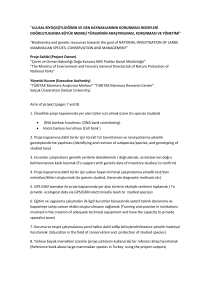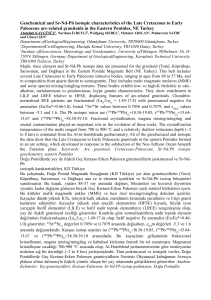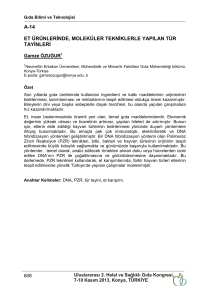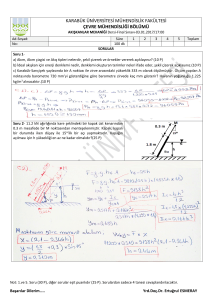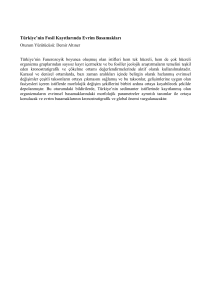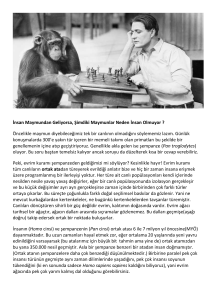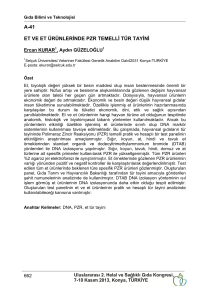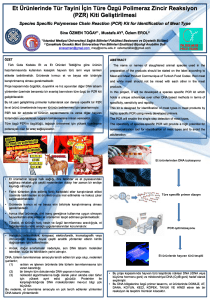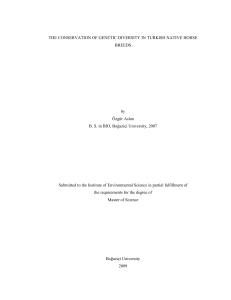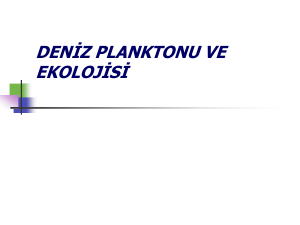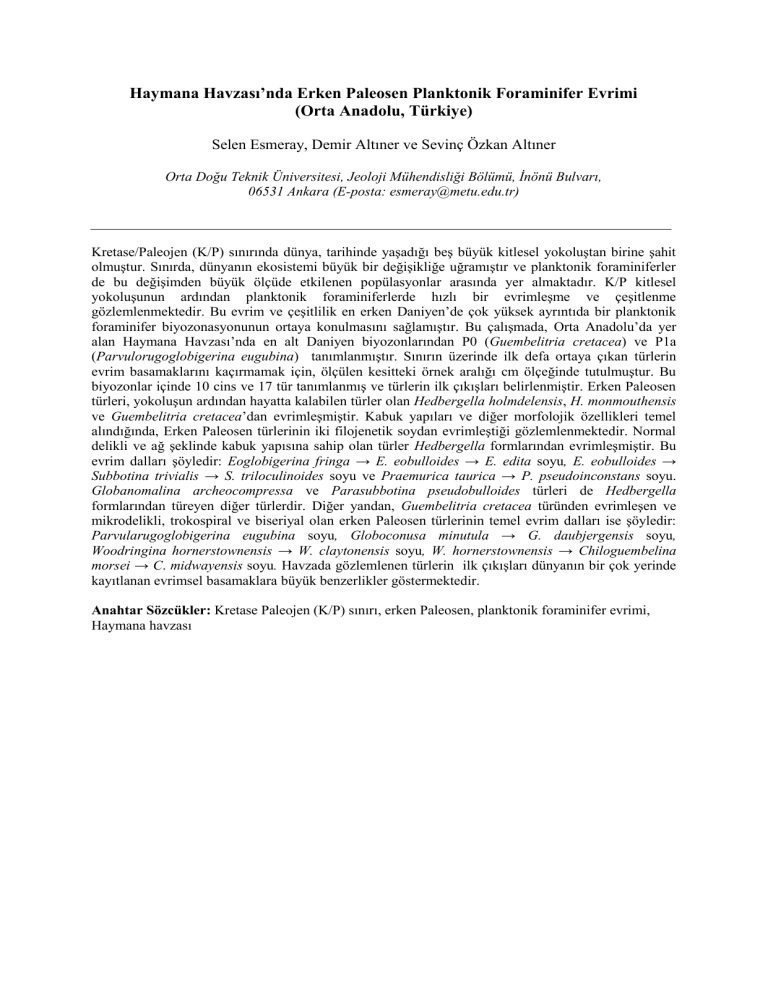
Haymana Havzası’nda Erken Paleosen Planktonik Foraminifer Evrimi
(Orta Anadolu, Türkiye)
Selen Esmeray, Demir Altıner ve Sevinç Özkan Altıner
Orta Doğu Teknik Üniversitesi, Jeoloji Mühendisliği Bölümü, İnönü Bulvarı,
06531 Ankara (E-posta: esmeray@metu.edu.tr)
Kretase/Paleojen (K/P) sınırında dünya, tarihinde yaşadığı beş büyük kitlesel yokoluştan birine şahit
olmuştur. Sınırda, dünyanın ekosistemi büyük bir değişikliğe uğramıştır ve planktonik foraminiferler
de bu değişimden büyük ölçüde etkilenen popülasyonlar arasında yer almaktadır. K/P kitlesel
yokoluşunun ardından planktonik foraminiferlerde hızlı bir evrimleşme ve çeşitlenme
gözlemlenmektedir. Bu evrim ve çeşitlilik en erken Daniyen’de çok yüksek ayrıntıda bir planktonik
foraminifer biyozonasyonunun ortaya konulmasını sağlamıştır. Bu çalışmada, Orta Anadolu’da yer
alan Haymana Havzası’nda en alt Daniyen biyozonlarından P0 (Guembelitria cretacea) ve P1a
(Parvulorugoglobigerina eugubina) tanımlanmıştır. Sınırın üzerinde ilk defa ortaya çıkan türlerin
evrim basamaklarını kaçırmamak için, ölçülen kesitteki örnek aralığı cm ölçeğinde tutulmuştur. Bu
biyozonlar içinde 10 cins ve 17 tür tanımlanmış ve türlerin ilk çıkışları belirlenmiştir. Erken Paleosen
türleri, yokoluşun ardından hayatta kalabilen türler olan Hedbergella holmdelensis, H. monmouthensis
ve Guembelitria cretacea’dan evrimleşmiştir. Kabuk yapıları ve diğer morfolojik özellikleri temel
alındığında, Erken Paleosen türlerinin iki filojenetik soydan evrimleştiği gözlemlenmektedir. Normal
delikli ve ağ şeklinde kabuk yapısına sahip olan türler Hedbergella formlarından evrimleşmiştir. Bu
evrim dalları şöyledir: Eoglobigerina fringa → E. eobulloides → E. edita soyu, E. eobulloides →
Subbotina trivialis → S. triloculinoides soyu ve Praemurica taurica → P. pseudoinconstans soyu.
Globanomalina archeocompressa ve Parasubbotina pseudobulloides türleri de Hedbergella
formlarından türeyen diğer türlerdir. Diğer yandan, Guembelitria cretacea türünden evrimleşen ve
mikrodelikli, trokospiral ve biseriyal olan erken Paleosen türlerinin temel evrim dalları ise şöyledir:
Parvularugoglobigerina eugubina soyu, Globoconusa minutula → G. daubjergensis soyu,
Woodringina hornerstownensis → W. claytonensis soyu, W. hornerstownensis → Chiloguembelina
morsei → C. midwayensis soyu. Havzada gözlemlenen türlerin ilk çıkışları dünyanın bir çok yerinde
kayıtlanan evrimsel basamaklara büyük benzerlikler göstermektedir.
Anahtar Sözcükler: Kretase Paleojen (K/P) sınırı, erken Paleosen, planktonik foraminifer evrimi,
Haymana havzası
Early Paleocene Planktonic Foraminiferal Evolution in the Haymana Basin,
Central Anatolia, Turkey
Selen Esmeray, Demir Altıner & Sevinç Özkan Altıner
Middle East Technical University, Department of Geological Engineering, İnönü Bulvarı,
TR06531 Ankara, Turkey (E-mail: esmeray@metu.edu.tr)
At the Cretaceous/Paleogene (K/P) boundary the earth underwent an extinction which was one of the
five big mass extinction events in the earth’s history. At the boundary the earth’s ecosystem has been
altered intensely and planktonic foraminifera species are among the populations which lived a great
turnover. After K/P boundary mass extinction, a rapid evolution and diversification occurred in the
planktonic foraminifera providing a very high resolution biozonation in the lowermost Danian. In this
study, the lowermost Danian biozones P0 (Guembelitria cretacea) and P1a (Parvulorugoglobigerina
eugubina) have been defined in the Haymana basin, Central Anatolia, Turkey. In order not to miss the
steps in the evolution of the early species, the section has been measured with a cm-scale sampling
interval. Within these biozones 10 genera and 17 species have been defined and the stepwise first
appearances of the species have been detected. The early Paleocene species are originated from the
survived species Hedbergella holmdelensis, H. monmouthensis and Guembelitria cretacea. Based on
the wall structure and other morphologic characteristics two phylogenic lineages in the evolution of
the early Paleocene species are observed. From Hedbergella forms, species having normal perforate
and cancellate wall structure have been evolved. The basic lineages observed are: Eoglobigerina
fringa → E. eobulloides → E. edita lineage, E. eobulloides → Subbotina trivialis →
S. triloculinoides lineage and Praemurica taurica → P. pseudoinconstans lineage. Globanomalina
archeocompressa and Parasubbotina pseudobulloides are the other species derived from Hedbergella
forms. On the other hand, microperforate trochospiral and biserial forms of early Paleocene evolved
from Guembelitria cretacea have the main lineages: Parvularugoglobigerina eugubina lineage,
Globoconusa minutula → G. daubjergensis lineage, Woodringina hornerstownensis →
W. claytonensis lineage, W. hornerstownensis → Chiloguembelina morsei → C. midwayensis lineage.
The stepwise first appearances of the species in the basin show prominent similarities with the
evolutionary steps recorded in many other localities of the world.
Key Words: Cretaceous/Paleogene (K/P) boundary, early Paleocene, planktonic foraminiferal
evolution, Haymana basin

